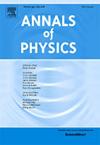具有各向异性流体的翘曲气泡几何形状:分段分析方法
IF 3
3区 物理与天体物理
Q2 PHYSICS, MULTIDISCIPLINARY
引用次数: 0
摘要
在经典广义相对论的框架下,对球对称的翘曲气泡构型进行了全面的分析研究。我们使用了一种简化的adm型度量,它具有微小的移差和非微小的径向位移函数,类似于painlev本文章由计算机程序翻译,如有差异,请以英文原文为准。
Warp bubble geometries with anisotropic fluids: A piecewise analytical approach
We present a comprehensive analytical study of spherically symmetric warp bubble configurations in the framework of classical general relativity. We use a simplified ADM-type metric with a trivial lapse and a non-trivial radial shift function, which resembles a Painlevé–Gullstrand type metric. Employing this metric, our approach leads naturally to an anisotropic energy–momentum tensor characterized by an equation of state that emerges naturally from the equations. To reconcile the strict boundary conditions with the requirement of a localized matter distribution, we adopt a piecewise—defined model for the energy density. This construction allows us to confine possible violations of the dominant energy condition to finite and controlled shells, while ensuring that the weak and null energy conditions are globally satisfied. We illustrate our method with two representative examples: a one-shell exponential decay profile and a double-shell profile incorporating an additional power-law factor. Our results demonstrate that, by properly tuning the model parameters, it is possible to design warp bubble geometries that are not only mathematically consistent, but also physically more feasible, providing a promising stepping stone towards the development of realistic warp bubble models.
求助全文
通过发布文献求助,成功后即可免费获取论文全文。
去求助
来源期刊

Annals of Physics
物理-物理:综合
CiteScore
5.30
自引率
3.30%
发文量
211
审稿时长
47 days
期刊介绍:
Annals of Physics presents original work in all areas of basic theoretic physics research. Ideas are developed and fully explored, and thorough treatment is given to first principles and ultimate applications. Annals of Physics emphasizes clarity and intelligibility in the articles it publishes, thus making them as accessible as possible. Readers familiar with recent developments in the field are provided with sufficient detail and background to follow the arguments and understand their significance.
The Editors of the journal cover all fields of theoretical physics. Articles published in the journal are typically longer than 20 pages.
 求助内容:
求助内容: 应助结果提醒方式:
应助结果提醒方式:


